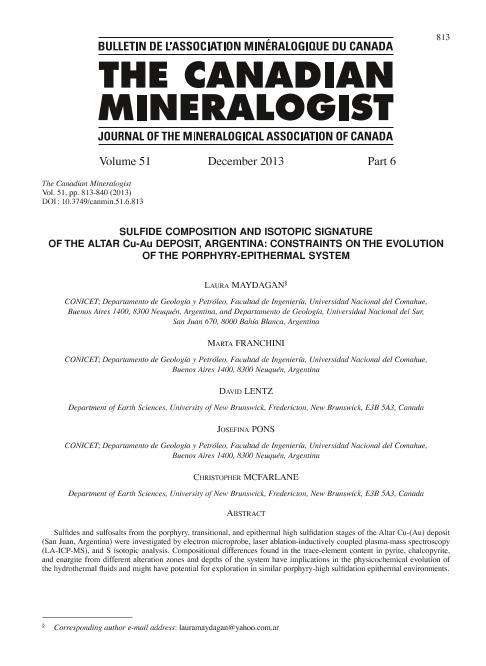Mostrar el registro sencillo del ítem
dc.contributor.author
Maydagán, Laura

dc.contributor.author
Franchini, Marta Beatriz

dc.contributor.author
Lentz, Dave
dc.contributor.author
Pons, María Josefina

dc.contributor.author
McFarlane, Christopher
dc.date.available
2016-12-07T21:29:15Z
dc.date.issued
2013-12
dc.identifier.citation
Maydagán, Laura; Franchini, Marta Beatriz; Lentz, Dave ; Pons, María Josefina; McFarlane, Christopher ; Sulfide Composition and Isotopic Signature of the Altar Cu-Au Deposit, Argentina: constraints on the Evolution of the Porphyry-Epithermal System; Mineralogical Assoc Canada; Canadian Mineralogist; 51; 6; 12-2013; 813-840
dc.identifier.issn
0008-4476
dc.identifier.uri
http://hdl.handle.net/11336/9065
dc.description.abstract
Sulfides and sulfosalts from the porphyry, transitional, and epithermal high sulfidation stages of the Altar Cu-(Au) deposit (San Juan, Argentina) were investigated by electron microprobe, laser ablation-inductively coupled plasma-mass spectroscopy (LA-ICP-MS), and S isotopic analysis. Compositional differences found in the trace-element content in pyrite, chalcopyrite, and enargite from different alteration zones and depths of the system have implications in the physicochemical evolution of the hydrothermal fluids and might have potential for exploration in similar porphyry-high sulfidation epithermal environments. Low contents of most analyzed trace elements were found in chalcopyrite ± pyrite from the potassic alteration, except for Zn, Sn, and Ag in chalcopyrite, and Co and Ni in pyrite. During the phyllic alteration, cooling of the fluids and a decrease of its pH (<4.5) produced the leaching and re-precipitation of the sulfides from the previous stage. The reprecipitated chalcopyrite and pyrite show micro-inclusions of Au (Ag alloys) and sulfosalts with As, Ag, V, Zn, Sn, Bi, and Sb that are interpreted to correlate with changes in the composition of the fluids. In the transitional veins and their selvages, early precipitation of bornite + pyrite and the weak kaolinite + quartz alteration envelope indicate a decrease in the temperature (<200 °C) and pH (<4) of the fluids and an increase of the fS2. This stage was followed by a sudden increase in the fO2 of the fluid and a slight decrease in the fS2, and bornite was replaced by tennantite (vein type E1). A trend toward higher fS2 favored enargite precipitation (vein type E3). Traces of Au found in tennantite and enargite therefore indicate that fluctuations in the oxidation state of the fluids promoted gold precipitation in the Altar porphyry system. Negative S isotope values (δ34S: –1.7 to –3.0‰) obtained for the sulfides and sulfosalts from the potassic, phyllic, and transitional stages at Altar are consistent with oxidizing (SO4 2– dominant) mineralizing fluids. The precipitation of sphalerite (δ34S = –4.4‰ and low concentration of FeS) and galena associated with calcite + anhydrite in late fractures (vein type 8) reflect cooling of the fluids and a slight increase of its pH at higher fO2, as the system moved to greater depths. The typical advanced argillic assemblages are not developed at the Altar porphyry deposit, indicating that fluids did not attain very low pH conditions. In contrast, enargite from the epithermal siliceous ledges located above the porphyry deposit precipitated with low pH mineral assemblages (quartz + alunite) and has a distinctive lighter δ34S value of –5.4‰, consistent with a decrease of temperature, pH, and/or an increase in the oxidation state of the fluids during its deposition. Enargite from the transitional stage veins of the porphyry deposit is enriched in Zn, Sb, Ag, and Bi, whereas enargite from the epithermal environment has much lower concentrations of trace elements, except for isolated inclusions of Au-Bi.
dc.format
application/pdf
dc.language.iso
eng
dc.publisher
Mineralogical Assoc Canada

dc.rights
info:eu-repo/semantics/openAccess
dc.rights.uri
https://creativecommons.org/licenses/by-nc-sa/2.5/ar/
dc.subject
Trace Elements
dc.subject
Sulfides
dc.subject
S Isotopes
dc.subject
Porphyry-Epithermal
dc.subject.classification
Geología

dc.subject.classification
Ciencias de la Tierra y relacionadas con el Medio Ambiente

dc.subject.classification
CIENCIAS NATURALES Y EXACTAS

dc.title
Sulfide Composition and Isotopic Signature of the Altar Cu-Au Deposit, Argentina: constraints on the Evolution of the Porphyry-Epithermal System
dc.type
info:eu-repo/semantics/article
dc.type
info:ar-repo/semantics/artículo
dc.type
info:eu-repo/semantics/publishedVersion
dc.date.updated
2016-12-06T16:32:16Z
dc.journal.volume
51
dc.journal.number
6
dc.journal.pagination
813-840
dc.journal.pais
Canadá

dc.journal.ciudad
Toronto
dc.description.fil
Fil: Maydagán, Laura. Consejo Nacional de Investigaciones Científicas y Técnicas; Argentina. Universidad Nacional del Comahue. Facultad de Ingenieria. Departamento de Geologia y Petroleo; Argentina
dc.description.fil
Fil: Franchini, Marta Beatriz. Consejo Nacional de Investigaciones Científicas y Técnicas; Argentina. Universidad Nacional del Comahue. Facultad de Ingenieria. Departamento de Geologia y Petroleo; Argentina
dc.description.fil
Fil: Lentz, Dave . University of New Brunswick. Department of Earth Sciences; Canadá
dc.description.fil
Fil: Pons, María Josefina. Consejo Nacional de Investigaciones Científicas y Técnicas; Argentina. Universidad Nacional del Comahue. Facultad de Ingenieria. Departamento de Geologia y Petroleo; Argentina
dc.description.fil
Fil: McFarlane, Christopher . University of New Brunswick. Department of Earth Sciences; Canadá
dc.journal.title
Canadian Mineralogist

dc.relation.alternativeid
info:eu-repo/semantics/altIdentifier/url/http://www.canmin.org/content/51/6/813.abstract
dc.relation.alternativeid
info:eu-repo/semantics/altIdentifier/doi/http://dx.doi.org/10.3749/canmin.51.6.813
Archivos asociados
